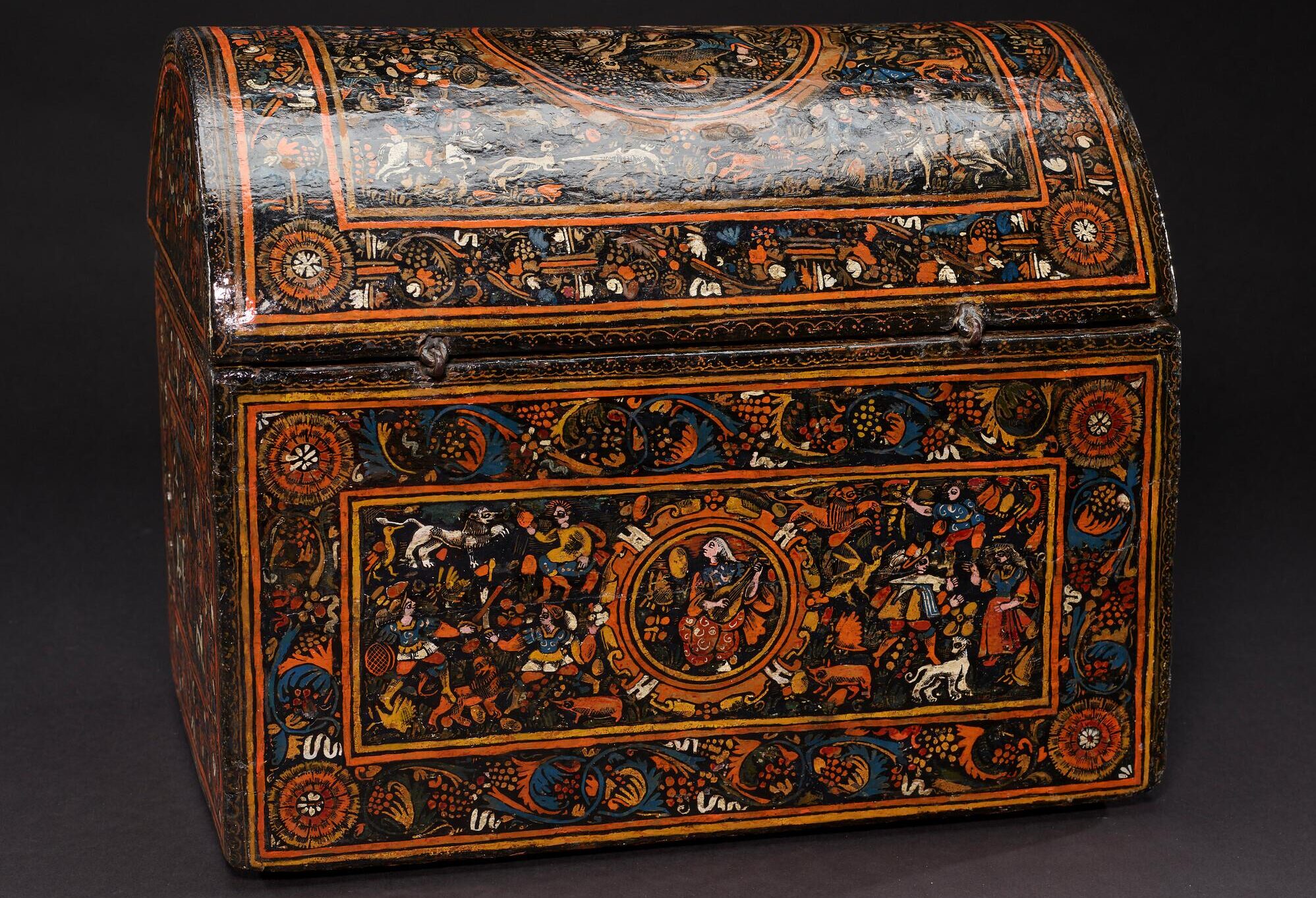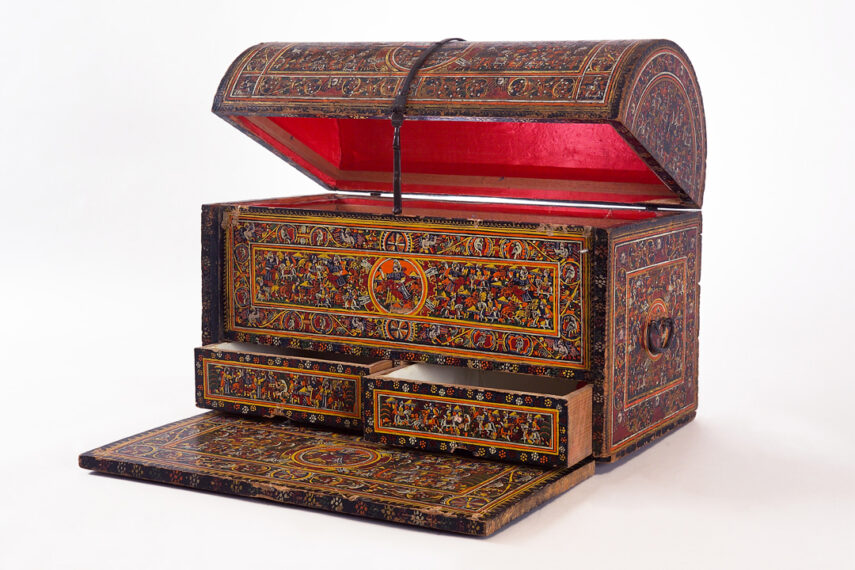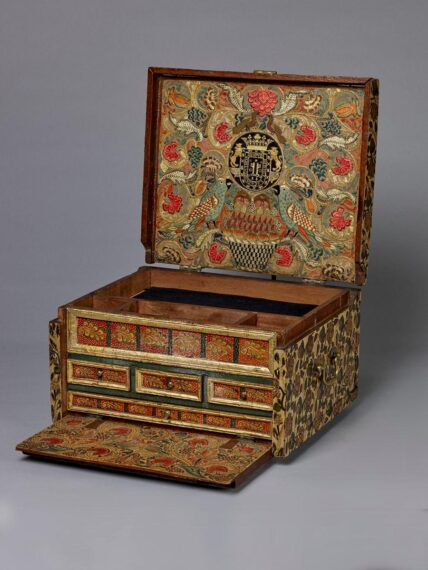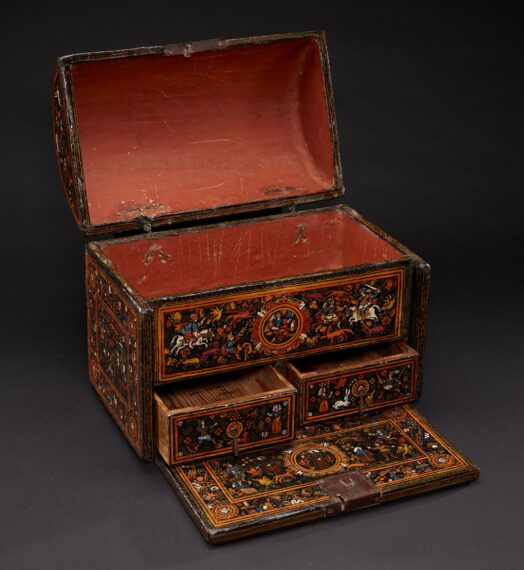
Lobby Object Highlight—Hispanic Heritage Month: Portable Writing Desk (Bufetillo)
By Laura Silver
September 2, 2025—This lavishly decorated little lacquered box, or bufetillo, from 1600s Mexico, is both beautiful and useful. It may have been used as a storage chest, a decorative object and status symbol, or, most intriguing, as a portable writing desk, with nifty compartments inside to store precious writing tools—an early remote workstation!
But more than that, it represents how Indigenous artisans in colonial Mexico (New Spain) blended local materials and ancient techniques with Asian and European styles, cementing Mexico’s central role in the early modern global trade network.
By the time the Spanish arrived in Mexico in 1519, Indigenous artisans had long perfected a centuries-old tradition of lacquered crafts, particularly in the Michoacán region, in west-central Mexico. They mixed natural pigments with insect wax (aje) and chia seed oil to make a paste and applied it in layers. (Raise your hand if you’d rather put chia seeds in lacquer than smoothies.)
Later, thanks to Mexico’s geographic position at the heart of the Viceroyalty of New Spain—which included much of Central America, parts of the West Indies, United States, South America (including Colombia), and the Philippines—artisans were exposed to global goods. They saw European forms, like furniture and writing boxes, and admired classic Asian motifs, like mythological animals and miniature landscapes. Then they adapted, merging, reinventing, and re-exporting these goods in a brand-new form. Their lacquered products were a hit in Europe. Soon colonial elites in Mexico were clamoring for luxury goods too.
Bufetillos were symbols of status and taste. The rich lacquer finishes and colorful designs made them prized for display in reception rooms, churches, libraries, and private studies. They were glowing centerpieces in otherwise austere or dark interiors, showing its owner’s education, sophistication, and access to luxury.
But they weren’t just decorative objects. Ladies used them for storing jewelry, letters, or personal belongings. In monasteries, churches, and missions, they stored relics, manuscripts, or vestments. And they were also used as functional writing desks. (They weren’t desks in the modern sense but were multifunctional storage boxes that converted into writing stations.)
They were small and portable, perfect for the tasteful, stylish business traveler. Their portability and internal organization made them valuable tools for people who needed to write, store, and transport documents in an era when paper, ink, and writing tools were precious. With bufetillos like these, who needs The Container Store?

Mexico (Michoacán), Casket, c. 1600, wood, pigment, iron, 48.5 × 66 × 35 cm. Royal Collections Gallery, Madrid, 00612072
Some bufetillos, like this one from the Royal Collections Gallery in Madrid, had handles for easy transport.

Pasto, Colombia, Portable writing desk, c. 1684, Barniz de Pasto lacquer on wood, 19 × 36 × 30.5 cm. New York, The Hispanic Society of America, LS2000
And this one, from the collection of the Hispanic Society Museum & Library in New York, from Pasto, Colombia, took its inspiration from Asian porcelains and lacquers, as well as from European heraldry and mythology.

Lid up, drawers out, writing surface down! Mexico, Portable writing desk (Bufetillo), 17th century, lacquered wood, wrought iron. The Putnam Dana McMillan Fund, 2016.38a-d
Mia’s bufetillo is a classic example of the genre: a domed or rectangular chest with a hinged lid made of wood, with lacquered decorations of floral, geometric, or figurative motifs, as well as narrative scenes—in this case, hunters on horseback, dueling swordsmen, and courting couples.
When opened, it reveals a flat interior surface that serves as a writing area—smooth, durable, and lacquered to resist ink—two drawers, and a large interior compartment. The user would sit on a low stool or mat, placing the bufetillo on a table or stand, or on their lap (if small enough). The locking mechanism ensured privacy and security for personal documents or correspondence.
On View Now
You can get a closer look at this 17th-century “laptop” in Mia’s lobby, on view now in honor of Hispanic American Heritage Month (September 15–October 15, 2025).
